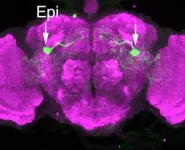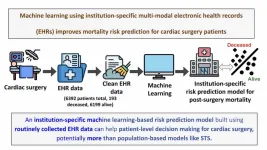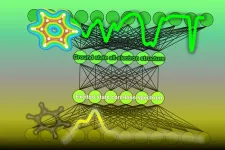(Press-News.org) Pain is good. It’s the body’s way to keep an animal from harming itself or repeating a dangerous mistake. But sometimes the debilitating sensation can get in the way. So evolution has devised ways to tamp that response down under certain circumstances.
Researchers at UC Santa Barbara identified the pathway in fruit flies that reduces the sensation of pain from heat. Remarkably, just a single neuron on each side of the animal’s brain controls the response. What’s more, the molecule responsible for suppressing this sensation in adult flies has the opposite role in fly larvae. The surprising results appear in Current Biology.
The brain of a fruit fly has about a million-fold fewer neurons than our own. “Yet we didn’t anticipate that a single pair of neurons would have such an important role in pain suppression,” said senior author Craig Montell, Duggan professor and distinguished professor of molecular, cellular and developmental biology.
“We call them ‘Epione,’ or Epi neurons, for the Greek goddess of soothing pain,” said first author Jiangqu Liu, a postdoctoral fellow in the Montell lab.
The authors are quick to clarify a point. “Pain is an interpretation,” Montell said. “A hardy smack on the back from a teammate after a win might feel great, but not from a bully on the playground. Since we can’t ask fruit flies about their interpretation of hot temperatures, a more accurate term is ‘nociception,’ which refers to how the body senses a potentially harmful stimulus, and then relays the information to induce an avoidance response.”
Humans are well known to be able to suppress pain under some situations. However, scientists don’t know much about suppression of nociception in flies, which are workhorses for sensory research. Montell and his lab wanted to determine if flies have such a system, and if so, locate the neurons involved and understand the mechanism.
The researchers focused on nociception in response to heat. They first needed a way to measure how the animals responded to hot temperatures. They placed flies on a hot plate and measured the number that jumped off within 10 seconds. Nearly all the flies jumped between 38° and 44° Celsius (roughly 100° to 111° Fahrenheit). Now the team set out to see if they could identify neurons that suppress their aversion to high temperatures, and reduce the jump response.
Locating the neurons
The authors wondered whether the neurons involved in suppressing thermal pain might express a particular neuropeptide. Neuropeptides are a bit like neurotransmitters, except that neurotransmitters mediate between adjacent neurons, while neuropeptides can have a more systemic effect. As a result they impact many behaviors. Different sets of neurons tend to express different neuropeptides. Liu, Montell and their co-authors used the DNA segments that control the expression of 35 different neuropeptide genes to drive expression of a protein that activates neurons.
Out of the 35 different groups of neurons, one clearly reduced the flies’ tendency to jump from the hot plate. These neurons produce the neuropeptide AstC, which is related to a mammalian compound that contributes to pain suppression in humans.
The researchers then expressed the gene coding for a light-sensitive channel in this group of neurons. This enabled them to activate the neurons using light. As expected, stimulating these neurons reduced the flies’ tendency to jump off the hot plate.
The authors then used the section of DNA that controls expression of AstC to instead control a gene for green fluorescent protein. Now they could finally see which neurons were activating. That’s when they discovered that triggering just a single neuron on each side of the brain (the Epi neurons) suppressed the nociceptive response.
Finding the trigger
Once the team found the neurons responsible for suppressing thermal pain, they were curious whether Epi neurons were thermosensitive themselves, or were receiving a signal from some other neurons.
The researchers expressed a gene coding for a protein that would fluoresce when calcium ions flooded into Epi neurons. They found that calcium levels increased as the temperature rose, even when they used a chemical to block communication between neurons. These findings indicated that the Epi neurons were directly sensing the high temperature.
The researchers determined that a specific ion channel in the cell membrane of Epi neurons was responsible for detecting the heat. This channel, called “Painless,” is a member of the TRP family of channels. TRP channels have broad roles in sensation, including temperature sensation. In fact, Painless is also required for thermal nociception in fly larvae. “So Painless can have opposite roles in the response to noxious heat,” Montell said. “In some neurons, the channel is required for the animal to escape from hot temperatures, while in Epi neurons, Painless is needed to suppress nociception. That is an interesting and surprising twist.”
“This is the first time, to my knowledge, that a TRP channel is found to sense noxious heat not to induce a nociceptive response, but to suppress it,” Montell added.
To recap: the authors found that there is a mechanism to suppress thermal nociception in flies, and they discovered that it is mediated by a single pair of neurons, called Epi neurons. They also found that Epi neurons respond directly to heat, and that this ability depends on a previously known TRP channel called Painless, which can actually trigger nociception in fly larvae. The team also found that heat activates Epi neurons directly, causing them to release the neuropeptide AstC. This compound then binds to the AstC-R1 receptor in other neurons that is related to mammalian opiod receptors.
The team plans to further investigate the pathways involved in this anti-nociception response. For instance, they hope to identify the neurons that function downstream of those that express AstC-R1. Their work raises the question as to whether a thermally-activated TRP channel might suppress nociception in mammals as well. If so, Montell suspects it would be found in our extremities rather than the brain, since mammals maintain a constant internal temperature, unlike fruit flies.
END
A channel involved in pain sensation can also suppress it
Researchers at UC Santa Barbara identify the pathway in fruit flies that reduces the sensation of pain from heat. The molecule responsible has the opposite role in fly larvae.
2023-05-17
ELSE PRESS RELEASES FROM THIS DATE:
Genetic research offers new perspective on the early evolution of animals
2023-05-17
A study published by MBARI researchers and their collaborators today in Nature provides new insights about one of the earliest points in animal evolution that happened more than 700 million years ago.
For more than a century, scientists have been working to understand the pivotal moment when an ancient organism gave rise to the diverse array of animals in the world today. As technology and science have advanced, scientists have investigated two alternative hypotheses for which animals—sponges or comb jellies, also known as ctenophores—were most distantly related to all other animals. Identifying this outlier—known as the sibling ...
Research spotlight: a conversational artificial intelligence program can generate credible medical information in response to common patient questions
2023-05-17
What was the question you set out to answer with this study?
ChatGPT, a new language processing tool driven by artificial intelligence (AI), provides conversational text responses to questions and can generate valuable information for enquiring individuals, but the quality of ChatGPT-generated answers to medical questions is currently unclear.
What Methods or Approach Did You Use?
We retrieved eight common questions and answers about colonoscopy from the publicly available webpages of three randomly-selected hospitals from the top-20 list of the US News & World Report Best Hospitals for Gastroenterology and Gastrointestinal Surgery.
We ...
How breast cancer arises
2023-05-17
In what may turn out to be a long-missing piece in the puzzle of breast cancer, Harvard Medical School researchers have identified the molecular sparkplug that ignites cases of the disease currently unexplained by the classical model of breast-cancer development.
A report on the team’s work is published May 17 in Nature.
“We have identified what we believe is the original molecular trigger that initiates a cascade culminating in breast tumor development in a subset of breast cancers that are driven by estrogen,” said study senior investigator Peter Park, professor of ...
Astronomers find potentially volcano-covered Earth-size world
2023-05-17
Cambridge, Mass. – Astronomers have discovered an Earth-size exoplanet, a world beyond the solar system, that may be carpeted with volcanoes and could potentially support life. Called LP 791-18 d, the planet could undergo volcanic outbursts as often as Jupiter’s moon Io, the most volcanically active body in the solar system.
The planet was first reported in Nature and the discovery was made possible in part due to ground-based observations made by the Center for Astrophysics | Harvard & Smithsonian.
LP 791-18 d orbits a small red dwarf star about 90 light-years away in a southern constellation called Crater. The ...
Vigorous exercise not tied to increased risk of adverse events in rare heart condition
2023-05-17
Vigorous exercise does not appear to increase the risk of death or life-threatening arrhythmia for people with hypertrophic cardiomyopathy (HCM), according to a study supported by the National Institutes of Health. HCM is a rare, inherited disorder that causes the heart muscle to become thick and enlarged and affects 1 in 500 people worldwide. It has been associated with sudden cardiac death in young athletes and other young people. However, the study, published in JAMA Cardiology, found that people with the disease who exercise vigorously are no more likely to die or experience severe cardiac events than those who exercised moderately ...
Climate change made record Asia humid heatwave at least 30 times more likely: attribution study
2023-05-17
Human-caused climate change made April’s record-breaking humid heatwave in Bangladesh, India, Laos and Thailand at least 30 times more likely, according to rapid attribution analysis by an international team of leading climate scientists as part of the World Weather Attribution group. The study also concludes that the high vulnerability in the region, which is one of the world’s heatwave hotpots, amplified the impacts.
In April, parts of south and southeast Asia experienced an intense heatwave, with record-breaking temperatures that passed 42ºC in Laos and 45°C in Thailand. The heat ...
Study finds link between deprived areas and number of children in care proceedings in England
2023-05-17
A strong link between the extent of deprivation of local authorities in England and their numbers of children going into the care system through the family courts has been uncovered by researchers at Lancaster University.
The study, available online and due to be published in July 2023 in the journal Children & Society, found that for every one unit increase in the standardized Office for National Statistics’ (ONS) English index of multiple area deprivation, the number of children in care proceedings in English family courts increased by around 70%.
The research team analysed data from the English Children and Family Court Advisory and Support Service ...
Call for papers: JMIR Dermatology special theme issue on teledermatology
2023-05-17
JMIR Dermatology—the official journal of the International Society of Teledermatology (ISTD)—and the journal’s guest editors welcome submissions to a special theme issue to coincide with the 10th ISTD World Congress held at the 23rd World Congress of Dermatology on July 4 to 7, 2023, in Singapore.
This theme issue will allow attendees of the ISTD World Congress to share their work with a wider audience by disseminating their work in a well-respected, peer-reviewed, open-access journal.
Teledermatology has been increasingly gaining recognition as a means of delivering dermatological ...
Researchers show that a machine learning model can improve mortality risk prediction for cardiac surgery patients
2023-05-17
A machine learning-based model that enables medical institutions to predict the mortality risk for individual cardiac surgery patients has been developed by a Mount Sinai research team, providing a significant performance advantage over current population-derived models.
The new data-driven algorithm, built on troves of electronic health records (EHR), is the first institution-specific model for assessing a cardiac patient’s risk prior to surgery, thus allowing health care providers to pursue the best course of action for that individual. The team’s work was described in a study published in The Journal of Thoracic and Cardiovascular Surgery ...
Machine learning lets researchers see beyond the spectrum
2023-05-17
Tokyo, Japan – Organic chemistry, the study of carbon-based molecules, underlies not only the science of living organisms, but is critical for many current and future technologies, such as organic light-emitting diode (OLED) displays. Understanding the electronic structure of a material’s molecules is key to predicting the material’s chemical properties.
In a study recently published by researchers at the Institute of Industrial Science, The University of Tokyo, a machine-learning algorithm was developed to predict the density ...
LAST 30 PRESS RELEASES:
Heart-brain connection: international study reveals the role of the vagus nerve in keeping the heart young
Researchers identify Rb1 as a predictive biomarker for a new therapeutic strategy in some breast cancers
Survey reveals ethical gaps slowing AI adoption in pediatric surgery
Stimulant ADHD medications work differently than thought
AI overestimates how smart people are, according to HSE economists
HSE researchers create genome-wide map of quadruplexes
Scientists boost cell "powerhouses" to burn more calories
Automatic label checking: The missing step in making reliable medical AI
Low daily alcohol intake linked to 50% heightened mouth cancer risk in India
American Meteorological Society announces Rick Spinrad as 2026 President-Elect
Biomass-based carbon capture spotlighted in newly released global climate webinar recording
Illuminating invisible nano pollutants: advanced bioimaging tracks the full journey of emerging nanoscale contaminants in living systems
How does age affect recovery from spinal cord injury?
Novel AI tool offers prognosis for patients with head and neck cancer
Fathers’ microplastic exposure tied to their children’s metabolic problems
Research validates laboratory model for studying high-grade serous ovarian cancer
SIR 2026 delivers transformative breakthroughs in minimally invasive medicine to improve patient care
Stem Cell Reports most downloaded papers of 2025 highlight the breadth and impact of stem cell research
Oxford-led study estimates NHS spends around 3% of its primary and secondary care budget on the health impacts of heat and cold in England
A researcher’s long quest leads to a smart composite breakthrough
Urban wild bees act as “microbial sensors” of city health.
New study finds where you live affects recovery after a hip fracture
Forecasting the impact of fully automated vehicle adoption on US road traffic injuries
Alcohol-related hospitalizations from 2016 to 2022
Semaglutide and hospitalizations in patients with obesity and established cardiovascular disease
Researchers ‘listen in’ to embryo-mother interactions during implantation using a culture system replicating the womb lining
How changing your diet could help save the world
How to make AI truly scalable and reliable for real-time traffic assignment?
Beyond fragmented markets: A new framework for efficient and stable ride-pooling
Can shape priors make road perception more reliable for autonomous driving?
[Press-News.org] A channel involved in pain sensation can also suppress itResearchers at UC Santa Barbara identify the pathway in fruit flies that reduces the sensation of pain from heat. The molecule responsible has the opposite role in fly larvae.





